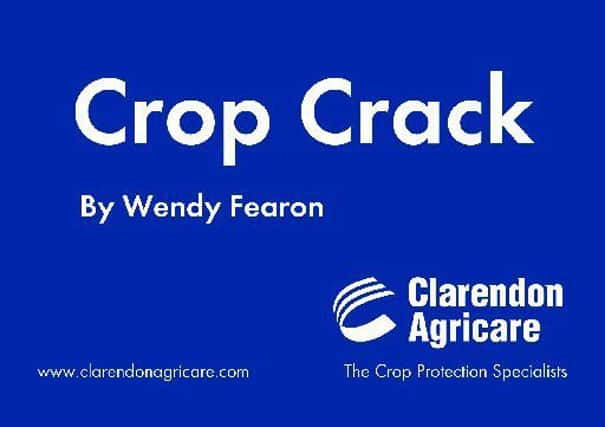Spring cereals


Although weeds are also emerging fast as a result of last weeks rain, be sure all are well through before spraying. Watch too the size of the annual meadow grass if this weed is also to be controlled - efficacy falls off rapidly once it begins to tiller.
A well timed application of SELON will encourage tiller numbers and tiller survival. This treatment must be well timed to maximise its effect, optimum timing for barley is from the two expanded leaf stage to beginning of tillering, GS12–21; in wheat the optimum timing is slightly later, five leaf to mid tillering, GS15-24. Many crops will have now passed through these growth stages. It is important to note that this season aphid numbers are the highest I have seen for a very long time and it would be advisable to apply an aphicide to control the spread of BYDV.
Advertisement
Advertisement
To minimise the effects of competition on the crop and optimise the level of weed control, herbicide application should be carried out once all weeds have emerged but are still small, and before they begin to compete with the crop for nutrients and light. Carrying out the weed control when they are at the two-four leaf stage is much more effective especially on difficult weeds such as fumitory and knotgrass, rather than delaying to coincide with the 1st fungicide application.
Broad leaved weeds resistant to particular groups of herbicides in NI is not a new problem – chickweed resistant to herbicides such as ALLY has been widespread throughout the province for some years. Sulfonyl urea (SU) herbicides such as metsulfuron have a single mode of activity, blocking the production in many BLW of a key enzyme, acetolactate synthase. Products that use this mode of activity are known as ALS inhibiting herbicides and include the SU chemistry. As well as chickweed, mayweed and poppy have also developed widespread ALS resistance. This particular resistance problem has been managed by including herbicides into the tank-mix with different modes of activity to maintain good weed control.
In NI spring cereals ZYPAR will give excellent control of a wide range of weeds that includes chickweed, fumitory, fat-hen, groundsel, brassica weeds, and cleavers. Its one relative weakness is redshank. Whilst it will control it to 6-leaf, it should be tank-mixed with another herbicide to ensure redshank right up to flowering is satisfactorily controlled. ALLY MAX and FOUNDATION are excellent tank-mix partners for this purpose.
Temporary nutrient issues
Manganese (Mn) deficiency is widespread in much of our local soil types, and particularly damaging to leaf vigour and yield if not treated. Continuous cereal cropping, ground recently limed and dry soils all increase the likelihood of deficiency. Symptoms begin with small pale green speckles appearing throughout the leaf and these will progress to turn brown unless treated. Barley is particularly susceptible to Mn deficiency. MAXMAN is a highly concentrated Mn(40%) in a completely soluble chelated nitrate formulation and also supplies 10.8% Nitrogen and 11.4% Sulphur
Advertisement
Advertisement
A young plant that is growing extremely rapidly is producing a huge amount of new plant tissue each day. This rapid growth is limited only by the availability of nutrients to synthesise biomass, dependant on soil fertility and the plant’s own root development to take up the nutrients. It is at this time therefore when nutrient deficiencies are most likely to appear and in doing so, suppress growth rates.
The application of a broad-spectrum trace-element mix along with key macronutrients during this time is a very useful and beneficial way to supplement the plant’s nutrient requirements during periods when availability does not meet demand, most likely to coincide with phases of rapid growth ie. during tillering and as stem extension begins. Application of a balanced and readily available source of macro and micronutrients that is topping up what is being made available from the soil at this key time will minimise the adverse effects of restricting nutrient availability. CEREAL HIGH N-supplies 250gm N, 125gm S, 38gm Mg, 93gm Mn, 45gm Cu and 15gm Zn per ha.
FASTMIX MAGNESIUM PLUS is an alternative product specifically formulated to meet the increased micronutrient demand of cereals and other combinable crops with good yield potential. It is a quick acting foliar fertiliser containing high levels of magnesium and sulphur as well as manganese, zinc and boron, all in a water soluble form and readily available to the plant. It is very compatible in tank-mix with most pesticides and can be applied along with the T1 and T2 fungicide applications. Being a dry formulation, it should be fully dissolved in the tank first and other products added afterwards.
Winter Cereals
Winter cereals have greened up well and are now racing through the growth stages. Awns are now out on all winter barley crops with both T2 application and growth regulator applications complete. Winter wheat crops which have not yet received T2 should be treated as soon as possible along with the growth regulator if required.